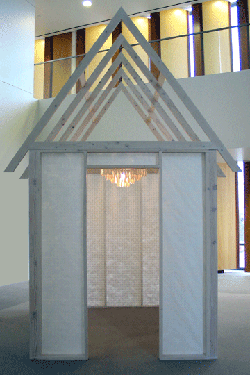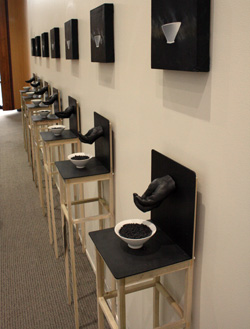
Tamara Scronce, Chain Reaction. CCAI Courthouse Gallery. Fall 2007. [photograph courtesy of the artist.]

Robert Morrison, Un Cigare Andalou, [detail]. CCAI
Courthouse Gallery. Fall 2007.
ROBERT MORRISON|TAMARA SCRONCE
Curator's Note:
The Capital City Arts Initiative is honored to present "Robert Morrison|Tamara Scronce" its fall 2007 exhibition at the CCAI Carson City Courthouse Gallery. The exhibition marks the first major exhibition featuring the sculpture faculty of the University of Nevada Reno Department of Art.
Following a visit to Carson City to view the exhibition and meet with the artists, San Francisco Bay Area arts writer Brent Foster Jones wrote the essay below. We thank Brent for the generosity of his time and insightful writing.
Jon Winet
December 2007
ROBERT MORRISON|TAMARA SCRONCE
Brent Foster Jones
In the late writer Vladimir Nabokov’s stylish, mesmerizing story “Mademoiselle O,” the narrator confesses, “the man in me revolts against the fictionist.” Here too, Nevada artists Tamara Scronce (b. 1963) and Robert Morrison (b. 1941) resist fictionalizing their visions of the world. Instead, they present site-specific installations of coded and private self –histories that are subtly in conversation with one another. Their spare, layered works reflect universal human struggles, including perfection and the constant need to adapt. As a pair—though distinct and separate from the other—the works meditate on notions of cycles, stability, and relationships: Scronce, a former art student of Morrison’s at the University of Nevada, Reno, asked him to join her in creating works of art specifically for this public thoroughfare. Morrison agreed, and the result is her Chain Reaction (2007) and his Un Cigare Andalou (2007). These works are also, as Scronce says of hers, “shared space.” That is, spaces designed with your physical presence in mind.
Scronce’s Chain Reaction is part house, part mythological symbol. Her piece is also an homage to Morrison, whose earlier work involved representations of houses.
Previous installations of Scronce’s arresting, psychological art probe themes of exhaustion and refuge, and her cycle-driven work has been recognized for its feminist themes. Her materials—typically ordinary domestic objects—tend to undergo kinds of transformations in her hands. For a previous installation, she cocooned a working vacuum cleaner inside approximately sixty pounds of beeswax. Another employed shredded bed linen, which she painstakingly unraveled.
In an effort to create a seamless, peaceful structure that is experiential—the piece in the Carson City Courthouse exhibition requires entry in order to confront its surrounding, privatizing traits—she obsessively sanded and white-washed inexpensive hardware store lumber, joining them via a system of dowels. Scronce says the work initially occurred to her as something she would “close in;” later, she understood the work would be a “solitary” environment. Or, a space “to encounter your sense of intimacy.”
Inside the installation, one is enveloped, floor to ceiling, by sheets of translucent wallpaper that feature a repeating, unfamiliar cicada nymph pattern—a coded language about geography, art making, family, and her relationship with Morrison. Although light comes in through the paper, the action and bustle at nearby counters is obscured. For a moment, one is safeguarded, protected. Above the viewer, a cicada wing porcelain chandelier is lit from within by a 25-watt Sylvania incandescent bulb. The experience is an artistic intervention—an invitation from Scronce to us to reflect and consider. The emotional nature and sensuality of Chain Reaction also evokes the strategies of installation artist Ann Hamilton, whose provocative, high-sensory pieces trigger momentary emotional associations.
For Scronce, the cicada cycle—she first observed their fragile, abandoned skins on mulberry trees in the late 1990s—is powerful and personal. Intrigued, she “harvested” the skins for future projects and did research, learning first-hand about their cycles.
As Scronce sees it, her own cycle begins with her childhood and undergraduate education in Reno, followed by a move to Chicago to continue her study of art. Not long after moving there, she returned to Nevada, residing in Las Vegas while she earned a master of fine arts. Her present home is Reno, where she directs the new graduate studio art program at the University of Nevada—the very institution she studied at under Morrison’s guidance. Returning home and re-inventing her relationship with Morrison from teacher and student to that of peers, completes a cycle for the artist.
Finally, Chain Reaction suggests the artist’s own stability and, as she says, “grounding.” In contrast to previous pieces in which she subverted and shape-shifted domestic things, she now offers us the house—the ultimate in domesticity—as an intimate, energizing sanctuary.
Not unlike Scronce’s work, Morrison’s seventeen sequenced “stations” of wood-masonite chairs, porcelain bowls, and paintings beckon and invite. But in contrast to hers, his piece—an L-shaped, dream-like tableau studded with sculpted, fibrous hands in a variety of gestures—possesses theatrical and biblical qualities. Un Cigare Andalou mischievously interrupts the comings and goings of this thoroughfare and recalls critic Michael Fried’s 1967 controversial “Art and Objecthood” essay, in which he theorized the idea that a minimalist sculpture might have “stage presence.”
The recipient of a National Endowment for the Arts grant and two Nevada State Arts Council awards, Morrison’s body of highly accomplished, minimalist sculpture and installation work was most recently featured in a 2004 retrospective at the Nevada Museum of Art. He is known for his use of steel, water, glass, and sound; his sleek, ensemble pieces negotiate his own past and explore ideas of anxiety, loss, and curiosity.
Morrison describes creating the work as a process of “gathering” elements and ideas, and prior to constructing his piece he spoke with Scronce about her decision to employ cicada imagery. In fact, he had long been aware of cicadas, in particular the acoustic similarities between the insects and that of electricity, that he experienced years ago on the Greek island of Paros.
Although known for his rogue, often unsettling use of “noise” in his art, here Morrison minimizes sound as a material. As one nears, and then advances through the stations of chair, bowl, hand, and painting, motion sensors trigger a sort of rustle and bubbling up of the steel shot that fills the bowls. For Morrison, the aural and visual effects are as if something is happening “underneath the surface of the earth.” Above, small paintings of earthy “steam vents” seemingly vibrate.
The installation unfolds as a kind of hypnotic, dreamy narrative: each molded hand, affixed to the wall, offers a slightly different gesture. In sequence, walking along the arms of the installations, small, clustering objects attempt to pierce the skins of some of the hands. Later, cicadas, amber-like and hard, burst out, not unlike the scene in the Luis Buñuel and Salvador Dali 1920s surrealist film Un Chien Andalou, in which ants crawl out of a hole in a hand. The film is a primary artistic reference for this piece and featured large as part of Morrison’s gathering process.
Storytelling—in all its forms, and not always in readily understood ways—is part of the DNA of Morrison’s art, and this installation, he says, is meant to be experienced sequentially. “You read it the way you would read a book.” Indeed, his work has an opening and a closing, providing a space for us to engage our senses and imaginations.
Brent Foster Jones
Oakland, California
December 2007
page revised: February 4, 2008 08:35 PST [gmt - 08:00]